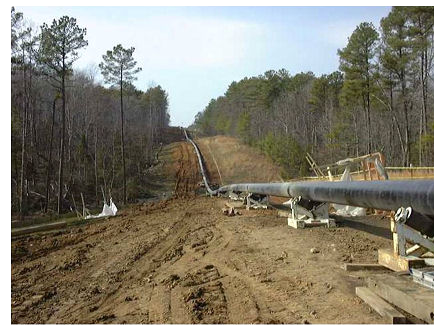Pipe Handling
A major advantage of HDPE pipe is its availability in continuous lengths on a reel, or in a coil, for a wide range of diameters (normally 6-inches or possibly greater). For HDPE products not available in continuous lengths, discrete lengths of HDPE pipe may be readily fused in the field, without an appreciable loss in the tensile capability required for HDD pulling operations.(ASTM International D 2657) In the latter case, the pipe should be assembled prior to the pullback operation to maintain continuity during the pipe placement process and avoid unnecessary delays. Significant interruptions may lead to increased drag and resulting pulling forces, including eventual loss of integrity and collapse of the bore hole, preventing further movement of the pipe.
ASTM International F1962 (Standard Guide for Use of Maxi-Horizontal Directional Drilling for Placement of Polyethylene Pipe or Conduit Under Obstacles, Including River Crossings) and PPI TR-46, (Guidelines for Use of Mini-Horizontal Directional Drilling for Placement of High Density Polyethylene Pipe) provide information regarding connecting the HDPE pipe to the drill rods for pull-back, including associated hardware:
- Gripping
- Swivel
- Breakaway Link
- Avoid supporting pipe on surface that may cause abrasion during pullback
- Minimize back tension on pipe, to prevent escalating effects at pulling end
- Avoid pulling around sharp bends (tighter than allowable bending radius), to avoid pipe collapse (kinking).
HDPE pipe has a very tight safe bend radius. This feature allows pipe to be strung on the ground in configurations impossible to do safely for other types of pipe. Instead of blocking cross streets the pipe is often laid down by simply bending it around the corner. For example a 12" HDPE pipe may be safely bent to a radius of only 28 ft, which allows this pipe to be placed in a typical cul-de-sac without fittings. In addition, HDPE pipe will almost always have a tighter bend radius than the drill stem being used for installation. This provides an extra safety factor against damaging the pipe by bending in the bore.

Product Pipe Support at Pipe Entry
(Source: Trenchless Engineering Corporation)